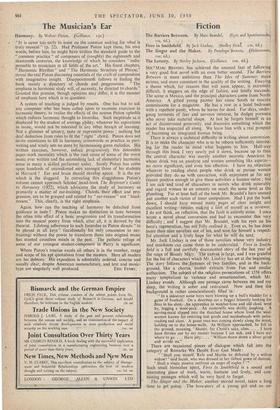Harmony. By Walter. Piston. (G011ancz. t es.)
" IT is never too early to insist on the constant seeking for what is truly musical " (p. 22). Had Professor Piston kept these, his own words, before him, he might have written the standard guide to the " common practice " of composers of (roughly) the eighteenth and nineteenth centuries, the knowledge of which he considers " indis- pensable to musicians in all fields of the art." His finest chapters, " Harmonic Rhythm " and " The Harmonic Structure of Phrase," reveal the real Piston discussing essentials of the craft-of composition with imaginative insight. Disappointment follows in finding the book mainly a directory of chords and progressions. " The emphasis in harmonic study will, of necessity, be directed to chords." Granted this premise, though opinions may differ, it is the manner of emphasis here which is in question.
A system of teaching is judged by results. One has but to ask any composer who has been called- upon to examine exercises in harmonic theory, to realise the effects of the system Piston upholds which reduces harmonic thought to formulae. Such ineptitude as is displayed by the student of average ability, whatever his aspirations in music, would not be tolerated in any other branch of learning. Not a glimmer of artistry, taste or expressive power ; nothing but deaf deduction from rules to fit the " right " chord. Piston does not invite uninitiates to fill in harmonic crosswords as practice in part- writing and wisely sets no store by harmonising given melodies. His written exercises, however, induce progressively this detestable paper-work mentality which is the root cause of some of the worst music ever written and the astonishing lack of elementary harmonic sense in many a skilled performer today. Surely Piston has come upon hundreds of unawakened ears amongst those of his students at 'Harvard ? Ear and brain should develop apace. It is the ear which is the sluggard. In correcting this sluggishness Piston's volume cannot approach Scholes' hand-book The Beginner's Guide to Harmony (1922), which advocates the study of harmony as primarily a matter of ear-training. Chords, their effect and pro- gression, are to be grasped and related by " ear-reason " not " head- reason." This, clearly, is the right emphasis.
Again, how can the teaching of harmony be detached from guidance in taste ? Piston makes no distinction in taste between the often trite effect of a basic progression and its transformation into the musical poetry from which, after all, it is derived, by the theorist. Lifelong adherence to such formulae as Piston directs " to be played in all keys" (incidentally his only concession to ear- training) without the power to transform them into original music has stunted countless minds in the past. The pathetic refuge of some of our youngest student-composers in Parry is significant.
Where Piston's treatise excels all others is in the number, range and scope of his apt quotations from the masters. Here all readers are his debtors. His exposition is admirably ordered, concise and usually clear, despite American nomenclature, and text and music-
type are singularly well produced. ERIC FENBY.














































 Previous page
Previous page